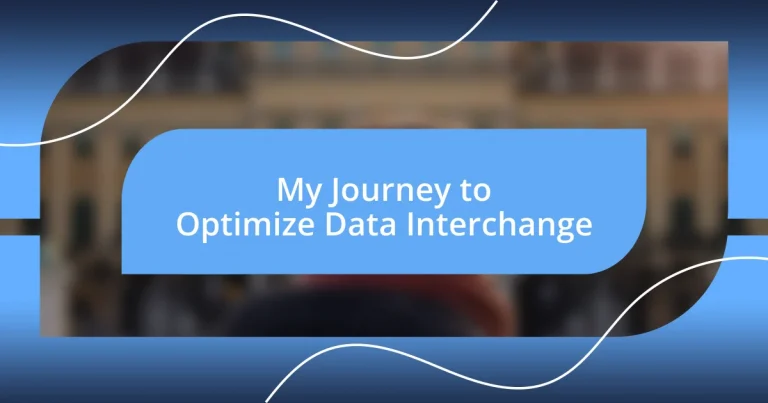Key takeaways:
- Standardized data formats like JSON, XML, and HL7 significantly enhance interoperability and streamline workflows.
- Continuous improvement through regular reviews, team collaboration, and automation optimizes data processes and reduces inefficiencies.
- Measuring success with KPIs and user feedback creates a roadmap for improvement and fosters team engagement in the data optimization journey.
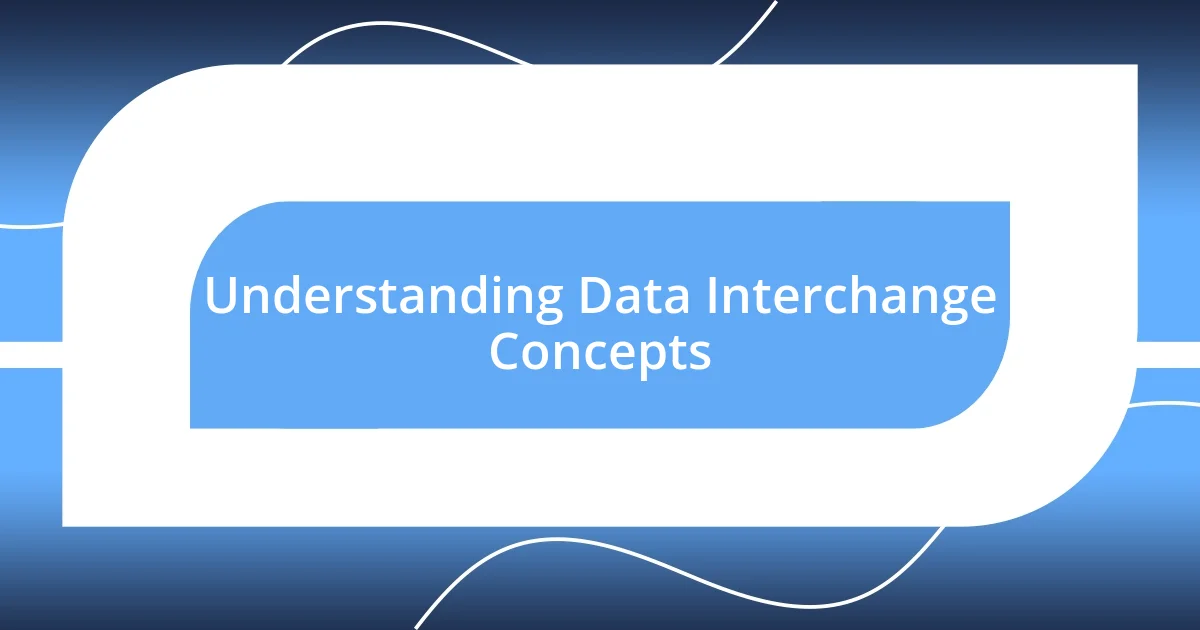
Understanding Data Interchange Concepts
Data interchange is the process of transferring data between different systems or formats. I vividly remember the first time I faced a data interoperability challenge. It was frustrating, realizing that two systems, which seemed so straightforward, could not speak to each other seamlessly. This led me to question: how can we bridge such gaps?
One important concept in data interchange is the use of standardized formats, like JSON and XML. These formats don’t just make data more accessible; they empower diverse systems to share information in meaningful ways. I recall a project where we transitioned from CSV files to JSON. The clarity and flexibility gained were empowering!
Moreover, protocols play a crucial role in facilitating smooth data exchange. I often think about how essential REST and SOAP protocols are in today’s digital landscape. They provide the guidelines and structure needed to enable communication. Can you imagine trying to send messages without a common language? That’s the beauty of these protocols; they act as translators in the complex world of data interchange.
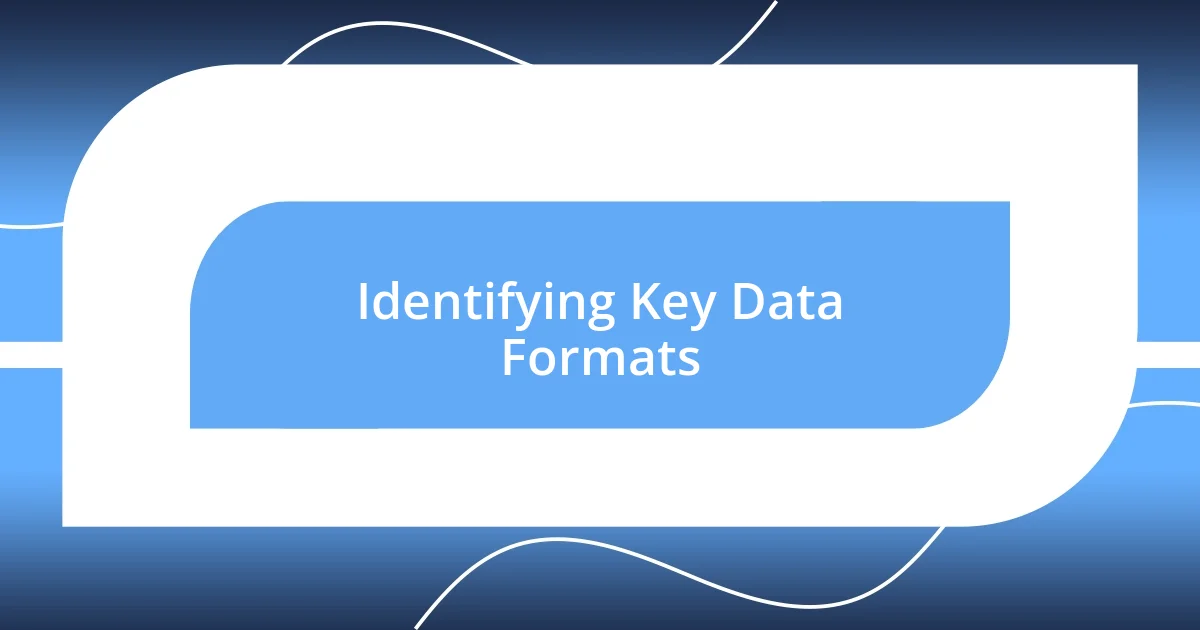
Identifying Key Data Formats
Identifying the right data formats is crucial in any data interchange strategy. Reflecting on my past experiences, I’ve often found that the choice of format can dramatically affect interoperability. For example, while working on a healthcare data project, I discovered that using HL7—a format designed specifically for health data—made the integration process much smoother. It truly underscored for me how the right format can eliminate compatibility headaches and streamline workflows.
Here are some key data formats I frequently encounter:
- JSON (JavaScript Object Notation): Lightweight and easy to read, perfect for web APIs.
- XML (eXtensible Markup Language): Structured and versatile, ideal for complex documents.
- CSV (Comma-Separated Values): Simple and widely used, but comes with limitations in structure.
- Parquet: A columnar storage file format optimized for large data sets, enhancing performance.
- HL7: Specifically for healthcare data, ensuring compatibility across various systems.
Transitioning from one format to another can be daunting, but when I see the impact on operational efficiency, it feels incredibly rewarding. Finding that perfect fit not only simplifies processes but also revitalizes my passion for seamless data integration.
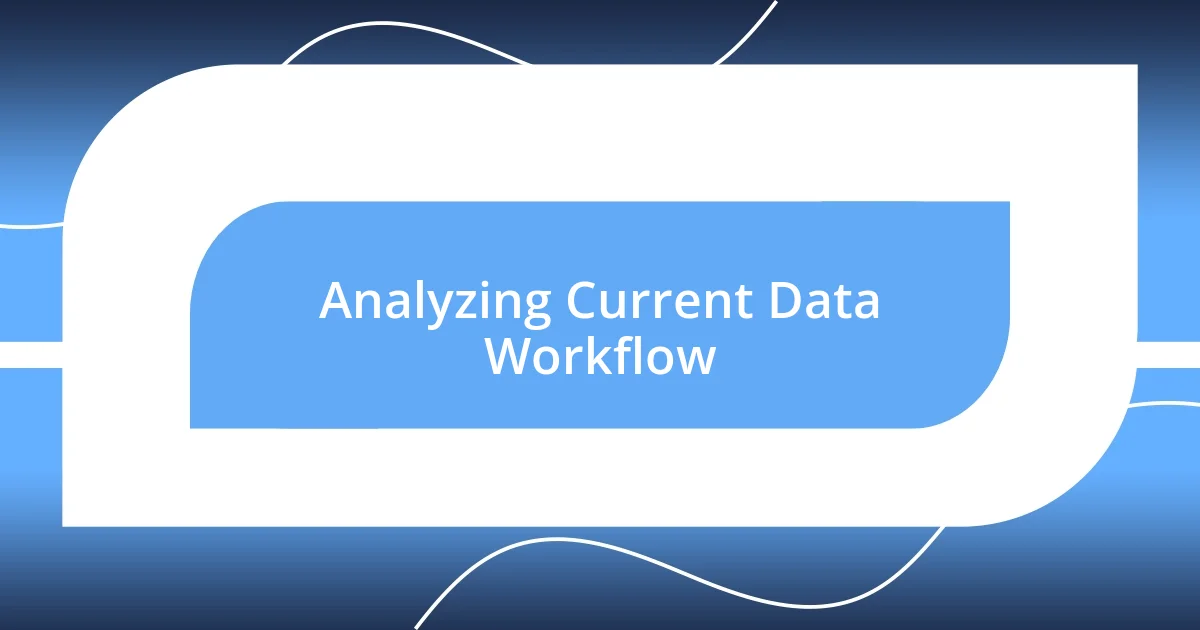
Analyzing Current Data Workflow
When I first set out to analyze our current data workflow, I was amazed at how many processes were outdated or inefficient. It was like peeling back layers of an onion—each layer revealed more bottlenecks than the last. I remember one particular instance where our team spent hours merging two separate databases manually. This kind of inefficiency had a tangible cost in both time and morale, making me realize that optimization was not just a theoretical exercise—it was essential.
In today’s data-driven landscape, mapping out the data flow visually can be incredibly revealing. I recall creating a simple flowchart that showcased how data moved through our systems. Suddenly, I could pinpoint redundancies and areas for improvement. The insights from just that flowchart were invaluable, sparking discussions on how we could leverage automation to enhance efficiency. Often, it’s in these moments of revelation that I feel a renewed sense of purpose in my work.
Moreover, I believe that feedback from team members is crucial in this analysis phase. Listening to their experiences sheds light on everyday challenges that might not be immediately evident. One of my colleagues mentioned how manual data entry often led to errors, reinforcing my view that collaboration is key in refining our data workflow. By combining our collective insights, I felt we could build a more efficient, robust data interchange system.
| Current Workflow Aspect | Challenges Identified |
|---|---|
| Manual Data Entry | High error rates and time-consuming processes |
| Aging Systems | Incompatibility with modern formats |
| Lack of Standardization | Difficulties in data interchange between different platforms |
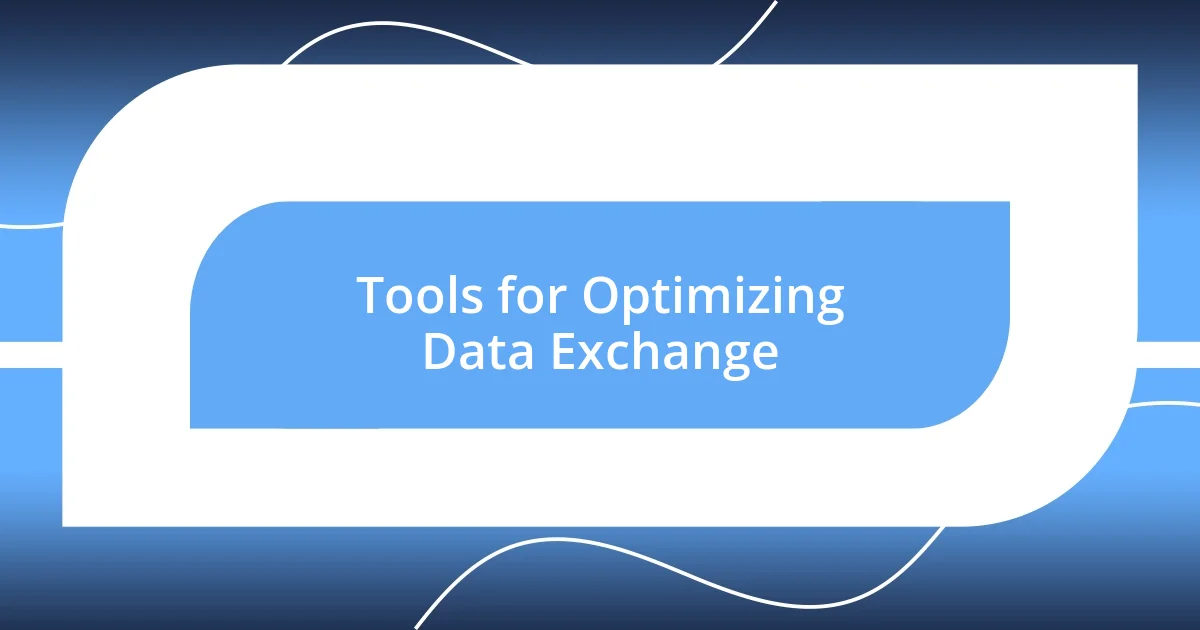
Tools for Optimizing Data Exchange
When it comes to optimizing data exchange, I’ve found that choosing the right tools can make all the difference. Tools like Apache NiFi have been game-changers for me, allowing for powerful data routing and transformation with a user-friendly interface. Imagine being able to visualize data flows in real-time—it’s almost like watching a river move effortlessly through a landscape. Isn’t it fascinating how a good tool can reshape our approach to data?
On another note, I’ve greatly benefited from using ETL (Extract, Transform, Load) tools, such as Talend or Apache Spark. They allow me to automate the process of data cleaning, transforming, and loading into data warehouses. I remember struggling with manual data manipulation in previous projects; it was tedious and fraught with errors. Now, I can focus on analysis rather than getting bogged down in the minutiae, which feels like a breath of fresh air.
Lastly, integrating APIs for real-time data exchange is a vital practice I’ve embraced. Using tools like Postman to test API endpoints has saved me hours of troubleshooting and ensures seamless data retrieval. I can’t help but reflect on how much smoother my projects run now. Have you ever thought about how much time you could save by automating these connections? With the right tools in place, I’ve experienced a shift from frustration to a sense of accomplishment, knowing that I can manage data efficiently and effectively.
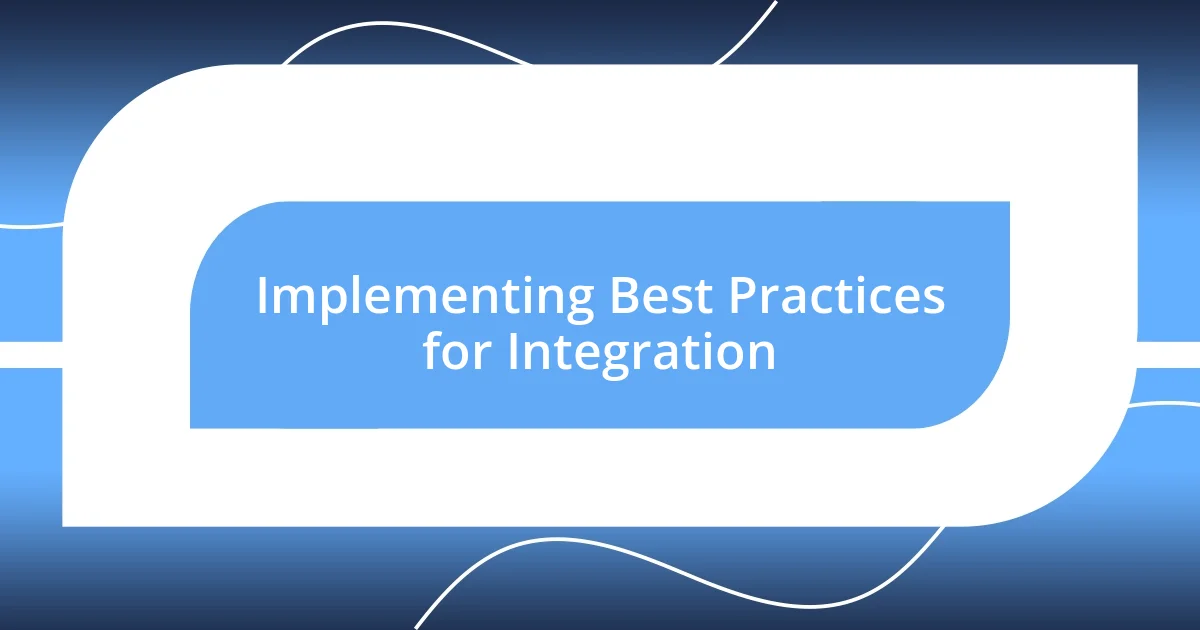
Implementing Best Practices for Integration
Implementing best practices for integration is something that has transformed my approach to managing data. One of the most crucial steps I discovered is creating standard protocols for data formats. I remember when we standardized our CSV exports, and it was like flipping a switch. Suddenly, our data pulled seamlessly into analytics tools, saving us hours that we previously spent troubleshooting format errors. Don’t you just love that moment when everything clicks into place?
Regularly reviewing and updating integration processes is another practice that has kept our systems running smoothly. I once fell into the trap of assuming our initial setup was sufficient. However, after a particularly frustrating day of data mismatches, I realized that periodic assessments were essential. Since implementing quarterly reviews, I’ve seen significant improvements in data accuracy and efficiency. It’s funny how a simple habit change can lead to such profound effects, isn’t it?
Lastly, I’ve found that fostering a culture of open communication about integration challenges can have a remarkable impact. During a team meeting, I shared my struggles with data inconsistency, which opened the floodgates for others to voice their concerns as well. By collaborating on solutions together, we’ve developed a more robust framework. This experience taught me that sometimes the best practices stem from collective insight, making us not just better at integrating data, but also a more cohesive team willing to tackle challenges head-on.
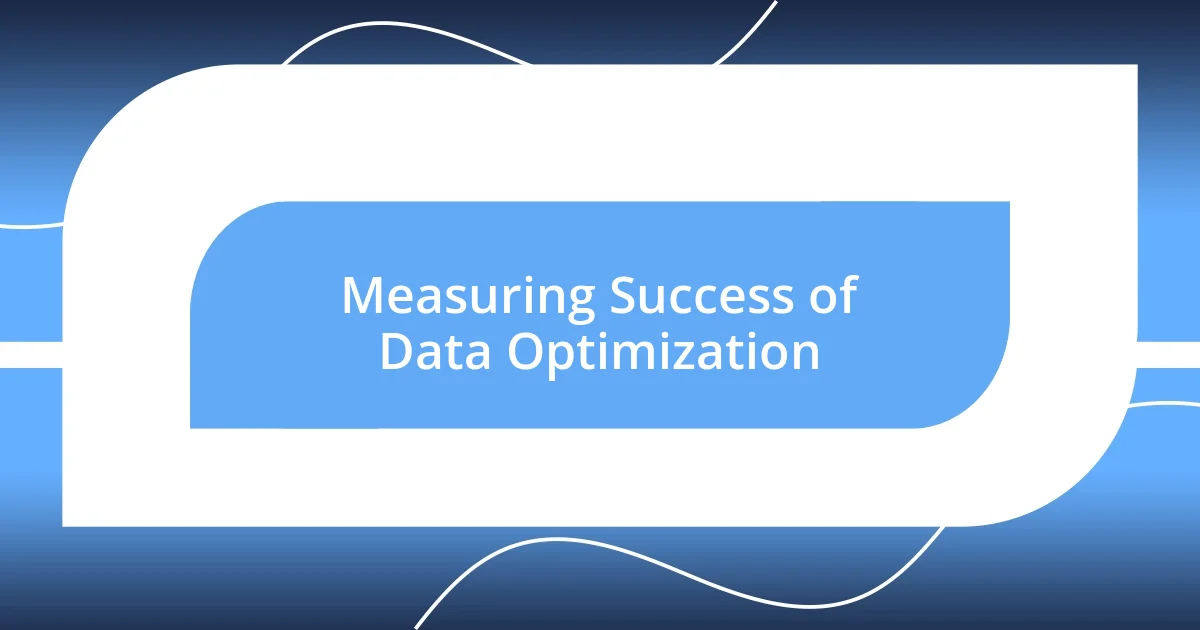
Measuring Success of Data Optimization
Measuring the success of data optimization is where the real insights come to life. I recall a moment when we noticed a drastic reduction in data retrieval times after implementing our new optimization strategies. This wasn’t just a numerical victory; it felt rewarding to see our efforts reflected in tangible performance upgrades. Have you ever experienced that rush when efficiency skyrockets? It’s a powerful motivator that keeps the momentum going.
In my experience, defining clear KPIs (Key Performance Indicators) has been crucial for evaluating data optimization. For example, tracking the accuracy of data inputs versus outputs became a real eye-opener for our team. When we established specific benchmarks, it felt like we were giving ourselves a roadmap; I could pinpoint exactly where we needed to improve and celebrate our wins along the way. It’s amazing how focusing on measurable outcomes can transform abstract goals into concrete achievements.
I also emphasize the importance of user feedback in measuring success. After one notable project, I gathered input from team members using the optimized data tools. Their insights revealed not just how the changes improved their efficiency, but also highlighted areas we hadn’t even considered. Asking for their thoughts was a game-changer, turning a one-sided evaluation into a collaborative experience. Have you thought about how the voices of your team can guide your next steps? It’s an enlightening approach that fosters both improvement and camaraderie.
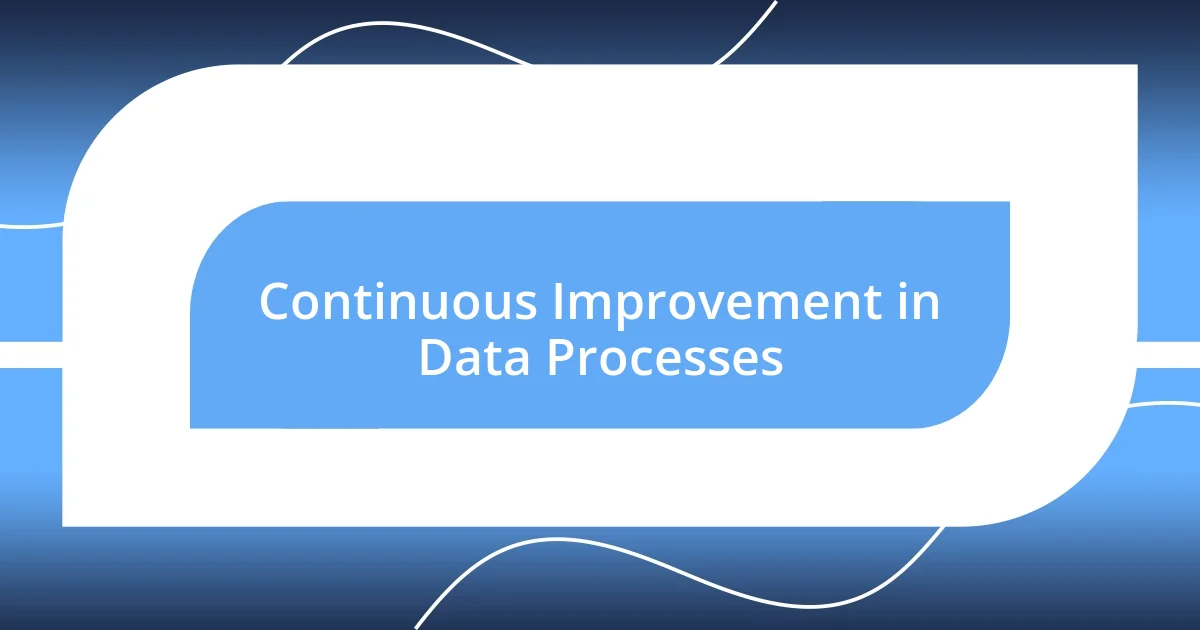
Continuous Improvement in Data Processes
Continuous improvement in data processes is a journey I’ve embraced wholeheartedly. I vividly remember the day we first introduced automation to our data entry. The relief I felt when I realized that tasks we used to dread – like manually checking for duplicates – could be handled instantly was exhilarating. Have you ever felt that rush of liberation when redundant tasks just vanish? It’s a game-changer that not only boosts efficiency but also inspires a sense of creativity in tackling more complex problems.
One key insight from my journey has been the role of continuous training for our team. I make it a point to organize regular workshops that focus on emerging data technologies and methodologies. When we first started, I invited an expert to facilitate a session on data visualization tools, and the spark it ignited in my colleagues was phenomenal. Watching them experiment and share newfound knowledge has enhanced our data processes significantly. How often do we overlook the power of investing in our team’s growth? It’s a refreshing reminder that improvement isn’t solely about systems; it’s about people, too.
Moreover, I’ve learned that documenting our progress allows for reflection and innovation. After every major project, I encourage our team to share lessons learned and insights gained. This practice has led to an unexpected treasure trove of actionable ideas that we can implement in future cycles. During our last review, someone suggested a new data validation method that completely reshaped our accuracy checks. Isn’t it incredible how a simple reflection can lead to breakthrough moments? It has truly cemented in me the belief that continuous improvement is an evolving journey, shaped by both successes and challenges.












